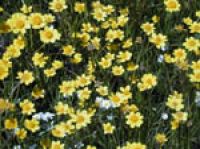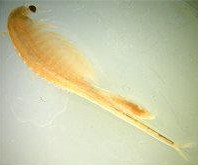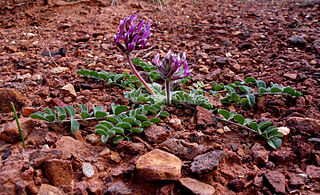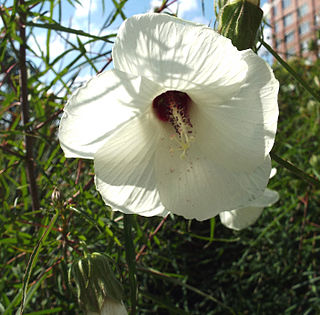
The Hine's emerald is an endangered dragonfly species found in the United States and Canada. Populations exist in Illinois, Michigan, Missouri, Ontario, and Wisconsin. Larvae are found in shallow, flowing water in fens and marshes, and often use crayfish burrows. Major threats to the species include habitat loss and alteration, and the species is legally protected in both the United States and Canada.

Helonias bullata is a rare perennial rhizomatous herb native to the eastern United States, in the genus Helonias together with Helonias orientalis (Thunb.) N.Tanaka. The root system is extensive in comparison to the apparent size of the plant on the surface. Blooming in March to May, its fragrant flowers are pink and occur in a cluster at the end a vertical spike which may reach up to 3' in height. It has evergreen, lance-shaped, and parallel-veined leaves ranging from dark green to light yellow green in color that form a basal rosette.

Lasthenia conjugens, commonly known as Contra Costa goldfields, is an endangered species of wildflower endemic to a limited range within the San Francisco Bay Area of the state of California, USA. Specifically this rare species occurs in Napa, Santa Barbara, Solano, Contra Costa, Santa Clara, Monterey and Alameda Counties. This annual herb typically flowers from March through June, and its colonies grow in vernal pool habitats at elevations not exceeding 100 meters above sea level. The Jepson Manual notes that the present distribution is limited to the deltaic Sacramento Valley, principally Napa and Solano Counties, but the historic range of L. conjugens is known to be significantly wider. In any case, historically the range has included parts of the North Coast, Sacramento Valley, and San Francisco Bay Area as well as the South Coast. Alternatively and less frequently this taxon has been referred to as Baeria fremontii var. conjugens.

The conservancy fairy shrimp is an endangered small crustacean in the family Branchinectidae. It ranges in size from about 1.25 centimetres (0.49 in) to 2.5 centimetres (0.98 in) long. This species is endemic to California in the United States.

Bensoniella is a monotypic genus of plants in the saxifrage family containing the single species Bensoniella oregona, which is known by the common name Oregon bensoniella, or simply bensoniella. This plant is endemic to the Klamath Mountains of northern California and southern Oregon. This is a plant of the wet forest understory and meadows above 1000 meters in elevation. It is a perennial herb which grows from a rhizome and bears rounded to heart-shaped lobed leaves with woolly petioles and tall, thin racemes of flowers. Each flower is white with bright yellow-pink anthers. The plant produces capsules of abundant seeds but also reproduces vegetatively. When it does reproduce sexually, it often self-pollinates. Bensoniella is not endangered but it is a species of some concern for several reasons, including lack of genetic diversity in part due to its habit of self-pollination and asexual reproduction, its relatively narrow tolerance of habitats, its small range of distribution, habitat destruction due to logging, grazing, and road-building, and erosion. The plant was first collected in 1916 by John Hunter Thompson.

Lindera melissifolia, common name pondberry or southern spicebush, is a stoloniferous, deciduous, aromatic shrub in the laurel family. This endangered species is native to the southeastern United States, and its demise is associated with habitat loss from extensive drainage of wetlands for agriculture and forestry. Restoration efforts are currently being conducted.

Lilium occidentale is a rare North American species of lily known by the common name western lily. Its species name 'Occidentale' means 'westernmost' and refers to its location along the West Coast. It is native to northwestern California and southwestern Oregon. It grows in coastal prairie habitat, swamps and stagnant bogs with Drosera species, bluffs and sandy cliffs, and seaside spruce forests. This rare wildflower is limited in distribution and directly endangered by a number of environmental factors. It is a federally listed endangered species and it is listed as endangered by the states of California and Oregon.

Dalea foliosa, commonly called leafy prairie clover, is a species of flowering plant in the legume family (Fabaceae). It is an endangered species in the United States, where it occurs in three states: Illinois, Tennessee, and Alabama.

Asclepias meadii is a rare species of milkweed known by the common name Mead's milkweed. It is native to the American Midwest, where it was probably once quite widespread in the tallgrass prairie. Today much of the Midwest has been fragmented and claimed for agriculture, and the remaining prairie habitat is degraded.

Astragalus holmgreniorum is a rare species of milkvetch known by the common names Holmgren milk-vetch and paradox milk-vetch. It is native to a tiny section of desert shrub woodland on the border between Utah and Arizona, in the far northern Mojave Desert. There are six populations remaining. It is a federally listed endangered species.

Castilleja levisecta is a rare species of flowering plant in the family Orobanchaceae known by the common name golden paintbrush, or golden Indian paintbrush, listed under the Endangered Species Act in 1997. It is native to British Columbia and Washington, where it is known from eleven remaining populations. It occurred in Oregon but all natural occurrences there have been extirpated. It has been reintroduced to a few areas in Oregon, but it remains to be seen if the plants will survive. The plant is a federally listed endangered species of Canada and was listed as threatened in the United States in 1997. On June 30, 2021, the plant was proposed for delisting due to recovery.

Cirsium vinaceum is a rare species of thistle known by the common name Sacramento Mountains thistle. It is endemic to Otero County, New Mexico, in the United States, where it is known only from the Sacramento Mountains. The plant can be found in six canyon systems in a southern section of this mountain range spanning about 32 kilometers. It is rare because it is limited to a specific type of mountain wetland which is both naturally uncommon and threatened by a number of forces. The plant was federally listed as threatened in 1987.

Clematis socialis is a rare species of flowering plant in the buttercup family known by the common name Alabama leather flower. It is native to the US states of Alabama and Georgia, where it is known from only five populations. The species is seriously threatened by habitat destruction. It is a federally listed endangered species.

Conradina verticillata is a flowering shrub in the mint family, found in the Cumberland Plateau. It is also called Conradina montana, Cumberland rosemary or Cumberland false rosemary. It has been classified as a threatened species under the Endangered Species Act since 1991.

Harperocallis flava, known by the common name Harper's beauty, is a species endemic to parts of Florida in the United States, where it is known mainly from the Apalachicola National Forest in the Panhandle. It is seriously endangered and has been on the United States' endangered species list since 1979.

Hedeoma todsenii is a rare species of flowering plant in the mint family known by the common name Todsen's pennyroyal, or Todsen's false pennyroyal. It is endemic to New Mexico in the United States, where it occurs in the San Andres and Sacramento Mountains. It is federally listed as an endangered species of the United States.

Mentzelia leucophylla, known by the common name Ash Meadows blazingstar, is a rare species of flowering plant in the Loasaceae. It is endemic to southwestern Nevada, in the Western United States.

Sidalcea nelsoniana is a rare species of flowering plant in the mallow family known by the common names Nelson's checkerbloom and Nelson's checkermallow. It is native to the Willamette Valley and Coast Range of Oregon and the southwestern corner of Washington in the United States. It is threatened by the destruction and degradation of its habitat, and it is a federally listed threatened species of the United States.

Hibiscus dasycalyx is a species of hibiscus known by the common name Neches River rosemallow. It is endemic to Texas in the United States, where there are three remaining natural populations and three introduced populations.
Brickellia mosieri, the Florida brickell-bush, is a North American herbaceous plant in the family Asteraceae. It grows in Pine Rocklands in Florida, preferring low-nutrient sand close to sea level. It is characterized by small, round, rod-shaped flowers that are either brown or white. Since 1999, the total population of the Florida brickell-bush has declined by 50% due to a number of threats. Currently, it is listed as “endangered wherever found” under the ESA





















